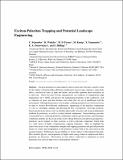Files in this item
Exciton-polariton trapping and potential landscape engineering
Item metadata
| dc.contributor.author | Schneider, C | |
| dc.contributor.author | Winkler, K | |
| dc.contributor.author | Fraser, M D | |
| dc.contributor.author | Kamp, M | |
| dc.contributor.author | Yamamoto, Y | |
| dc.contributor.author | Ostrovskaya, E A | |
| dc.contributor.author | Höfling, Sven | |
| dc.date.accessioned | 2017-11-15T00:33:27Z | |
| dc.date.available | 2017-11-15T00:33:27Z | |
| dc.date.issued | 2017-01 | |
| dc.identifier | 244440844 | |
| dc.identifier | cef94c52-24b8-4a71-9555-b320941328ce | |
| dc.identifier | 85006992078 | |
| dc.identifier | 000388607300001 | |
| dc.identifier.citation | Schneider , C , Winkler , K , Fraser , M D , Kamp , M , Yamamoto , Y , Ostrovskaya , E A & Höfling , S 2017 , ' Exciton-polariton trapping and potential landscape engineering ' , Reports on Progress in Physics , vol. 80 , no. 1 , 016503 . https://doi.org/10.1088/0034-4885/80/1/016503 | en |
| dc.identifier.issn | 0034-4885 | |
| dc.identifier.uri | https://hdl.handle.net/10023/12092 | |
| dc.description.abstract | Exciton-polaritons in semiconductor microcavities have become a model system for the studies of dynamical Bose-Einstein condensation, macroscopic coherence, many-body effects, nonclassical states of light and matter, and possibly quantum phase transitions in a solid state. These low-mass bosonic quasiparticles can condense at comparatively high temperatures up to 300 K, and preserve the fundamental properties of the condensate, such as coherence in space and time domain, even when they are out of equilibrium with the environment. Although the presence of an in-plane confining potential is not strictly necessary in order to observe Bose-Einstein condensation, engineering of the polariton confinement is a key to controlling, shaping, and directing the flow of polaritons. Prototype polaritonbased optoelectronic devices rely on ultrafast photon-like velocities and strong nonlinearities exhibited by polaritons, as well as on their tailored confinement. Nanotechnology provides several pathways to achieving polariton confinement, and the specific features and advantages of different methods are discussed in this review. Being hybrid exciton-photon quasiparticles, polaritons can be trapped via their excitonic as well as photonic component, which leads to a wide choice of highly complementary trapping techniques. Here we highlight the almost free choice of the confinement strengths and trapping geometries that provide powerful means for control and manipulation of the polariton systems both in the semi-classical and quantum regimes. Furthermore, the possibilities to observe effects of the polariton blockade, Mott insulator physics, and population of higher-order energy bands in sophisticated lattice potentials are discussed. Observation of such effects could lead to realization of novel polaritonic non-classical light sources and quantum simulators. | |
| dc.format.extent | 22 | |
| dc.format.extent | 20997192 | |
| dc.language.iso | eng | |
| dc.relation.ispartof | Reports on Progress in Physics | en |
| dc.subject | Excitons | en |
| dc.subject | Polaritons | en |
| dc.subject | Light-matter coupling | en |
| dc.subject | Semiconductors | en |
| dc.subject | Quantum optics | en |
| dc.subject | Microcavities | en |
| dc.subject | Bose-Einstein condensation | en |
| dc.subject | QB Astronomy | en |
| dc.subject | QC Physics | en |
| dc.subject | TK Electrical engineering. Electronics Nuclear engineering | en |
| dc.subject.lcc | QB | en |
| dc.subject.lcc | QC | en |
| dc.subject.lcc | TK | en |
| dc.title | Exciton-polariton trapping and potential landscape engineering | en |
| dc.type | Journal item | en |
| dc.contributor.institution | University of St Andrews. School of Physics and Astronomy | en |
| dc.contributor.institution | University of St Andrews. Condensed Matter Physics | en |
| dc.identifier.doi | https://doi.org/10.1088/0034-4885/80/1/016503 | |
| dc.description.status | Peer reviewed | en |
| dc.date.embargoedUntil | 2017-11-14 |
This item appears in the following Collection(s)
Items in the St Andrews Research Repository are protected by copyright, with all rights reserved, unless otherwise indicated.

